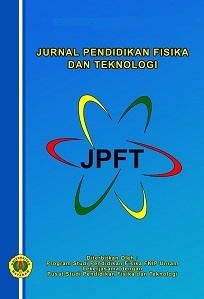Persepsi Calon Guru Terhadap Model E-Assessment Dalam Pembelajaran Fisika
DOI:
10.29303/jpft.v5i1.1164Published:
2019-07-01Issue:
Vol. 5 No. 1 (2019): Januari - JuniKeywords:
e-assessment, pre-service physics teachers, MoodleArticles
Downloads
How to Cite
Downloads
Metrics
Abstract
Assessment is an essential part of learning. The success of a lesson can be known from the results of the assessment carried out both in aspects of the process and product. Some problems related to conventional assessments have to find the right solution. One of them is through the use of computer technology in assessment, which can be used both online and offline in a model better known as e-assessment. The final goal of this research is to produce an e-assessment model that is oriented to the thinking ability of the physics teacher candidates. This research includes development research, using the DDD-E model, namely: decide, design, develop, and evaluate. This article discusses the responses of students and lecturers to the models that have been developed. Respondents gave a positive response to the development of this model. Student responses are at intervals of 86% to 94%, with excellent categories. This model has the opportunity to continue to be developed for evaluation effectively and efficiently.References
Adawiyah, R., Harjono, A., Gunawan, G., & Hermansyah, H. 2019. Interactive e-book of physics to increase studentsââ¬â¢ creative thinking skills on rotational dynamics concept. In Journal of Physics: Conference Series. 1153 (1), p. 012117.
Booth, R. et al. 2003. The Development of Quality Online Assessment in Vocational Education and Training Volume 1. Australia: NCVER.
Buzzetto-More, N. A., & Alade, A. J. 2006. Best practices in e-assessment. Journal of Information Technology Education: Research, 5(1), 251-269.
Finkelstein, N. D., Adams, W. K., Keller, C. J., Kohl, P. B., Perkins, K. K., Podolefsky, N. S., ... & LeMaster, R. 2005. When learning about the real world is better done virtually: A study of substituting computer simulations for laboratory equipment. Physical review special topics-physics education research, 1(1), 010103.
Garrison, D.R & Vaughan, N.D., 2008. Blended Learning in Higher Education. San Fransisco: John Willey & Sons, Inc.
Gunawan & Liliasari, 2012. Model Virtual Laboratory Fisika Modern untuk Meningkatkan Disposisi Berpikir Kritis Calon Guru. Jurnal Ilmiah Cakrwala Pendidikan, LPPMP UNY. Juni 2012, Th. XXXI, No. 2.185ââ¬â 199.
Gunawan, Harjono, A., Sahidu, H., Herayanti, L. 2017. Virtual Laboratory of Electricity Concept to Improve Prospective Physics Teachersââ¬â¢ Creativity. Jurnal Pendidikan Fisika Indonesia 13 (2), 102-111.
Gunawan, G., Harjono, A., Sahidu, H., & Herayanti, L. 2017. Virtual Laboratory to Improve Studentsââ¬â¢ Problem-Solving Skills on Electricity Concept. Jurnal Pendidikan IPA Indonesia, 6(2), 257-264.
Herayanti, L., Fuaddunnazmi, M., & Habibi, H. 2017. Pengembangan Perangkat Pembelajaran Fisika Berbasis Moodle. Jurnal Pendidikan Fisika dan Teknologi, 3(2), 197-206.
Irwan, A., Arsyad, M., & Arafah, K. 2018. Pengembangan Instrumen Penilaian Sikap Praktikum Fisika Dasar I Pada Mahasiswa Jurusan Pendidikan Fisika UIN Alauddin Makassar. Jurnal Pendidikan Fisika dan Teknologi, 4(2), 168-175.
Joint Information Systems Committee. 2010. Effective Assessment in a Digital Age. Higher Education Funding Council for England, Bristol.
Kendle, A., & Northcote, M. 2000. The struggle for balance in the use of quantitative and qualitative online assessment tasks. In Ascilite (Vol. 2002).
Mashami, R. A., & Gunawan, G. 2018. The Influence of Sub-Microscopic Media Animation on Students' Critical Thinking Skills Based on Gender. In Journal of Physics: Conference Series. 1108 (1), p. 012106.
Robles, M., & Braathen, S. 2002. Online assessment techniques. Delta Pi Epsilon Journal, 44(1), 39-49.
Sahidu, H., Gunawan, Indriaturrahmi, I., & Astutik, F. 2017. Desain Sistem E-Assessment pada Pembelajaran Fisika di LPTK. Jurnal Pendidikan Fisika dan Teknologi, 3(2), 265-270.
Sahidu, H., & Gunawan, G. 2019. Evaluasi Pendidikan Abad 21. Mataram: Arga Puji Press
Supriyadi. 2005. Kajian Penilaian Pencapaian Hasil Belajar Fisika. Malang: UM Press
Vendlinksi, T., & Stevens, R. 2002. Assessing student problem-solving skills with complex computer-based tasks. The Journal of Technology, Learning and Assessment, 1(3), 1-20.
Author Biographies
Hairunisyah Sahidu, (SCOPUS ID: 57196096064) Program Studi Pendidikan Fisika, Universitas Mataram
Gunawan Gunawan, Program Studi Pendidikan Fisika, Universitas Mataram
Lovy Herayanti, (SCOPUS ID: 57196098000) Pendidikan Fisika, IKIP Mataram
License
Authors who publish with Jurnal Pendidikan Fisika dan Teknologi (JPFT) agree to the following terms:
- Authors retain copyright and grant the journal right of first publication with the work simultaneously licensed under a Creative Commons Attribution License 4.0 International License (CC-BY-SA License). This license allows authors to use all articles, data sets, graphics, and appendices in data mining applications, search engines, web sites, blogs, and other platforms by providing an appropriate reference. The journal allows the author(s) to hold the copyright without restrictions and will retain publishing rights without restrictions.
- Authors are able to enter into separate, additional contractual arrangements for the non-exclusive distribution of the journal's published version of the work (e.g., post it to an institutional repository or publish it in a book), with an acknowledgement of its initial publication in Jurnal Pendidikan Fisika dan Teknologi (JPFT).
- Authors are permitted and encouraged to post their work online (e.g., in institutional repositories or on their website) prior to and during the submission process, as it can lead to productive exchanges, as well as earlier and greater citation of published work (See The Effect of Open Access).











